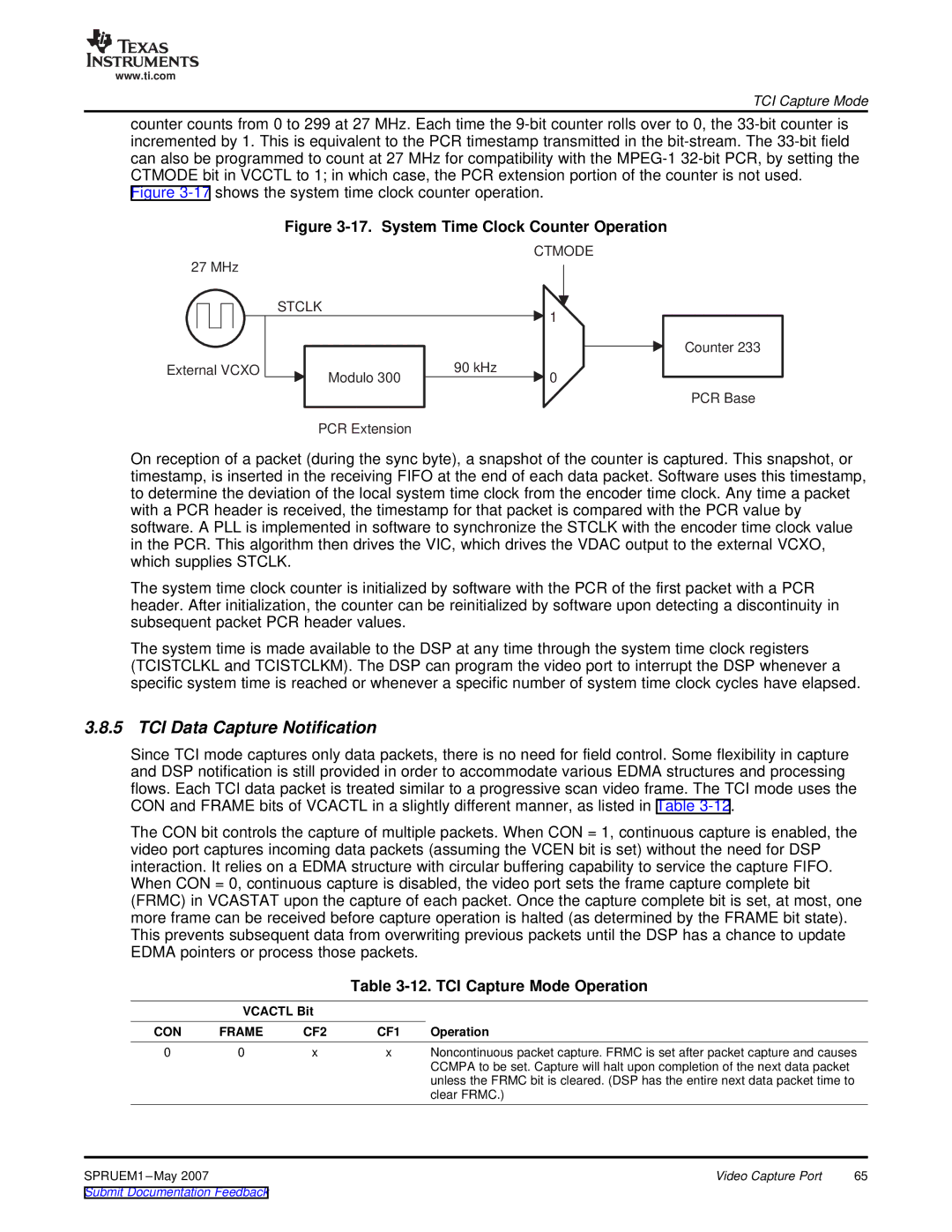
www.ti.com
TCI Capture Mode
counter counts from 0 to 299 at 27 MHz. Each time the
Figure 3-17 shows the system time clock counter operation.
Figure 3-17. System Time Clock Counter Operation
CTMODE
27 MHz
| STCLK | 1 |
|
| |
External VCXO | Modulo 300 | 90 kHz |
| 0 |
Counter 233
PCR Base
PCR Extension
On reception of a packet (during the sync byte), a snapshot of the counter is captured. This snapshot, or timestamp, is inserted in the receiving FIFO at the end of each data packet. Software uses this timestamp, to determine the deviation of the local system time clock from the encoder time clock. Any time a packet with a PCR header is received, the timestamp for that packet is compared with the PCR value by software. A PLL is implemented in software to synchronize the STCLK with the encoder time clock value in the PCR. This algorithm then drives the VIC, which drives the VDAC output to the external VCXO, which supplies STCLK.
The system time clock counter is initialized by software with the PCR of the first packet with a PCR header. After initialization, the counter can be reinitialized by software upon detecting a discontinuity in subsequent packet PCR header values.
The system time is made available to the DSP at any time through the system time clock registers (TCISTCLKL and TCISTCLKM). The DSP can program the video port to interrupt the DSP whenever a specific system time is reached or whenever a specific number of system time clock cycles have elapsed.
3.8.5 TCI Data Capture Notification
Since TCI mode captures only data packets, there is no need for field control. Some flexibility in capture and DSP notification is still provided in order to accommodate various EDMA structures and processing flows. Each TCI data packet is treated similar to a progressive scan video frame. The TCI mode uses the CON and FRAME bits of VCACTL in a slightly different manner, as listed in Table
The CON bit controls the capture of multiple packets. When CON = 1, continuous capture is enabled, the video port captures incoming data packets (assuming the VCEN bit is set) without the need for DSP interaction. It relies on a EDMA structure with circular buffering capability to service the capture FIFO. When CON = 0, continuous capture is disabled, the video port sets the frame capture complete bit (FRMC) in VCASTAT upon the capture of each packet. Once the capture complete bit is set, at most, one more frame can be received before capture operation is halted (as determined by the FRAME bit state). This prevents subsequent data from overwriting previous packets until the DSP has a chance to update EDMA pointers or process those packets.
Table 3-12. TCI Capture Mode Operation
| VCACTL Bit |
|
| |
CON | FRAME | CF2 | CF1 | Operation |
0 | 0 | x | x | Noncontinuous packet capture. FRMC is set after packet capture and causes |
|
|
|
| CCMPA to be set. Capture will halt upon completion of the next data packet |
|
|
|
| unless the FRMC bit is cleared. (DSP has the entire next data packet time to |
|
|
|
| clear FRMC.) |
SPRUEM1 | Video Capture Port | 65 |
Submit Documentation Feedback |
|
|
